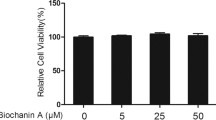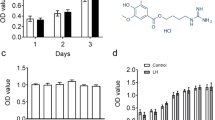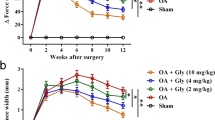Abstract
The aim of this study was to investigate the effects of trichostatin A (TSA) on expression of cathepsins in cartilage in experimental osteoarthritis (OA). OA was induced in 18 rabbits by bilateral anterior cruciate ligament transection (ACLT). Four weeks after surgery, rabbits received intra-articular injection with TSA dissolved in the dimethylsulphoxide (DMSO) in the right knees and DMSO in the left knees once a week for 5 weeks. Rabbits were killed 7 days after the last injection. The knee joints were assessed by morphological and histological examination. Messenger RNA expression of cathepsins K, B, L, S and cystatin C was studied by real-time PCR. TSA inhibited the expression of cathepsins K, B, L, S and cystatin C accompanied with the less degradation in cartilage. The results suggest that TSA exhibits protective effects against cartilage degradation in rabbits with OA and the effects may be associated with the inhibition of cathepsins.



Similar content being viewed by others
References
Tortorella MD, Malfait AM, Deccico C, Arner E (2001) The role of ADAM-TS4 (aggrecanase-1) and ADAM-TS5 (aggrecanase-2) in a model of cartilage degradation. Osteoarthr Cartil 9:539–552
Burrage PS, Mix KS, Brinckerhoff CE (2006) Matrix metalloproteinases: role in arthritis. Front Biosci 11:529–543
Yasuda Y, Kaleta J, Bromme D (2005) The role of cathepsins in osteoporosis and arthritis: rationale for the design of new therapeutics. Adv Drug Deliv Rev 57:973–993
Dodds RA, Connor JR, Drake FH, Gowen M (1999) Expression of cathepsin K messenger RNA in giant cells and their precursors in human osteoarthritic synovial tissues. Arthritis Rheum 42:1588–1593
Salminen-Mankonen HJ, Morko J, Vuorio E (2007) Role of cathepsin K in normal joints and in the development of arthritis. Curr Drug Targets 8:315–323
Dejica VM, Mort JS, Laverty S, Percival MD, Antoniou J, Zukor DJ et al (2008) Cleavage of type II collagen by cathepsin K in human osteoarthritic cartilage. Am J Pathol 173:161–169
Morko JP, Soderstrom M, Saamanen AM, Salminen HJ, Vuorio EI (2004) Up regulation of cathepsin K expression in articular chondrocytes in a transgenic mouse model for osteoarthritis. Ann Rheum Dis 63:649–655
Baici A, Lang A, Zwicky R, Muntener K (2005) Cathepsin B in osteoarthritis: uncontrolled proteolysis in the wrong place. Semin Arthritis Rheum 34(Suppl 2):24–28
Petanceska S, Canoll P, Devi LA (1996) Expression of rat cathepsin S in phagocytic cells. J Biol Chem 271:4403–4409
Nguyen Q, Mort JS, Roughley PJ (1990) Cartilage proteoglycan aggregate is degraded more extensively by cathepsin L than by cathepsin B. Biochem J 266:569–573
Lang A, Horler D, Baici A (2000) The relative importance of cysteine peptidases in osteoarthritis. J Rheumatol 27:1970–1979
Martel-Pelletier J, Cloutier JM, Pelletier JP (1990) Cathepsin B and cysteine protease inhibitors in human osteoarthritis. J Orthop Res 8:336–344
Connor JR, Lepage C, Swift BA, Yamashita D, Bendele AM, Maul D et al (2009) Protective effects of a cathepsin K inhibitor, SB-553484, in the canine partial medial meniscectomy model of osteoarthritis. Osteoarthr Cartil 17:1236–1243
Svelander L, Erlandsson-Harris H, Astner L, Grabowska U, Klareskog L, Lindstrom E et al (2009) Inhibition of cathepsin K reduces bone erosion, cartilage degradation and inflammation evoked by collagen-induced arthritis in mice. Eur J Pharmacol 613:155–162
Piekarz R, Bates S (2004) A review of depsipeptide and other histone deacetylase inhibitors in clinical trials. Curr Pharm Des 10:2289–2298
Chabane N, Zayed N, Afif H, Mfuna-Endam L, Benderdour M, Boileau C et al (2008) Histone deacetylase inhibitors suppress interleukin-1beta-induced nitric oxide and prostaglandin E2 production in human chondrocytes. Osteoarthr Cartil 16:1267–1274
Choi Y, Park SK, Kim HM, Kang JS, Yoon YD, Han SB et al (2008) Histone deacetylase inhibitor KBH-A42 inhibits cytokine production in RAW 264.7 macrophage cells and in vivo endotoxemia model. Exp Mol Med 40:574–581
Young DA, Lakey RL, Pennington CJ, Jones D, Kevorkian L, Edwards DR et al (2005) Histone deacetylase inhibitors modulate metalloproteinase gene expression in chondrocytes and block cartilage resorption. Arthritis Res Ther 7:R503–R512
Nasu Y, Nishida K, Miyazawa S, Komiyama T, Kadota Y, Abe N et al (2008) Trichostatin A, a histone deacetylase inhibitor, suppresses synovial inflammation and subsequent cartilage destruction in a collagen antibody-induced arthritis mouse model. Osteoarthr Cartil 16:723–732
Lin HS, Hu CY, Chan HY, Liew YY, Huang HP, Lepescheux L et al (2007) Anti-rheumatic activities of histone deacetylase (HDAC) inhibitors in vivo in collagen-induced arthritis in rodents. Br J Pharmacol 150:862–872
Bao JP, Chen WP, Feng J, Zhao J, Shi ZL, Huang K et al (2009) Variation patterns of two degradation enzyme systems in articular cartilage in different stages of osteoarthritis: Regulation by dehydroepiandrosterone. Clin Chim Acta 408:1–7
Jo H, Ahn HJ, Kim EM, Kim HJ, Seong SC, Lee I et al (2004) Effects of dehydroepiandrosterone on articular cartilage during the development of osteoarthritis. Arthritis Rheum 50:2531–2538
Shikhman AR, Amiel D, D’Lima D, Hwang SB, Hu C, Xu A et al (2005) Chondroprotective activity of N-acetylglucosamine in rabbits with experimental osteoarthritis. Ann Rheum Dis 64:89–94
Pritzker KP, Gay S, Jimenez SA, Ostergaard K, Pelletier JP, Revell PA et al (2006) Osteoarthritis cartilage histopathology: grading and staging. Osteoarthr Cartil 14:13–29
Kafienah W, Bromme D, Buttle DJ, Croucher LJ, Hollander AP (1998) Human cathepsin K cleaves native type I and II collagens at the N-terminal end of the triple helix. Biochem J 331:727–732
Burleigh MC, Barrett AJ, Lazarus GS (1974) Cathepsin B1. A lysosomal enzyme that degrades native collagen. Biochem J 137:387–398
Hou WS, Li Z, Buttner FH, Bartnik E, Bromme D (2003) Cleavage site specificity of cathepsin K toward cartilage proteoglycans and protease complex formation. Biol Chem 384:891–897
Kamolmatyakul S, Chen W, Yang S, Abe Y, Moroi R, Ashique AM et al (2004) IL-1alpha stimulates cathepsin K expression in osteoclasts via the tyrosine kinase-NF-kappaB pathway. J Dent Res 83:791–796
Ruettger A, Schueler S, Mollenhauer JA, Wiederanders B (2008) Cathepsins B, K, and L are regulated by a defined collagen type II peptide via activation of classical protein kinase C and p38 MAP kinase in articular chondrocytes. J Biol Chem 283:1043–1051
Kawaida R, Ohtsuka T, Okutsu J, Takahashi T, Kadono Y, Oda H et al (2003) Jun dimerization protein 2 (JDP2), a member of the AP-1 family of transcription factor, mediates osteoclast differentiation induced by RANKL. J Exp Med 197:1029–1035
Fabre C, Grosjean J, Tailler M, Boehrer S, Ades L, Perfettini JL et al (2008) A novel effect of DNA methyltransferase and histone deacetylase inhibitors: NFkappaB inhibition in malignant myeloblasts. Cell Cycle 7:2139–2145
Zhong H, May MJ, Jimi E, Ghosh S (2002) The phosphorylation status of nuclear NF-kappa B determines its association with CBP/p300 or HDAC-1. Mol Cell 9:625–636
Kawamata N, Chen J, Koeffler HP (2007) Suberoylanilide hydroxamic acid (SAHA; vorinostat) suppresses translation of cyclin D1 in mantle cell lymphoma cells. Blood 110:2667–2673
Akasaki Y, Matsuda S, Nakayama K, Fukagawa S, Miura H, Iwamoto Y (2009) Mevastatin reduces cartilage degradation in rabbit experimental osteoarthritis through inhibition of synovial inflammation. Osteoarthr Cartil 17:235–243
Jean YH, Wen ZH, Chang YC, Hsieh SP, Lin JD, Tang CC et al (2008) Increase in excitatory amino acid concentration and transporters expression in osteoarthritic knees of anterior cruciate ligament transected rabbits. Osteoarthr Cartil 16:1442–1449
Acknowledgments
This study was supported by grants from Health Bureau of Zhejiang Province (2006A055).
Author information
Authors and Affiliations
Corresponding author
Rights and permissions
About this article
Cite this article
Chen, WP., Bao, JP., Tang, JL. et al. Trichostatin A inhibits expression of cathepsins in experimental osteoarthritis. Rheumatol Int 31, 1325–1331 (2011). https://doi.org/10.1007/s00296-010-1481-7
Received:
Accepted:
Published:
Issue Date:
DOI: https://doi.org/10.1007/s00296-010-1481-7




